This news shouldn’t surprise you a bit, but given the global warming hysteria it might still do so.
According to a study published in The Lancet, cold weather is far more deadly than excessive heat. In fact, for every person in the world who dies due to some heat-related cause, 9 die due to excessive cold.
Common sense and the barest knowledge of history tells us this, and The Lancet’s study merely confirms (and amplifies) what every sentient human being already knows. It’s not like there are mass migrations of human beings from warmer climes to colder ones. People rarely retire to Siberia or even Minnesota. The flow goes the other direction.
Cold kills much more than heat on every continent
US+Canada: 20K heat but 171K cold (8x more)
Europe 179K vs 657K cold (4x)
Africa 1.2m cold deaths
Asia 2.4m cold deaths
Yet, most reporting focus on heat deaths, because it fits the climate narrativehttps://t.co/4k5eU2IaGa pic.twitter.com/TqdUxGwJ6H
— Bjorn Lomborg (@BjornLomborg) November 26, 2022
Step outside in 110 degree heat and pretty soon you will need a cold drink of water; do so in the dead of a Minnesota winter without extensive preparation and you could be dead within minutes.
Every winter I live in this Godforsaken state I marvel at how hostile the environment is to human existence. This winter hasn’t been particularly harsh in general, but we just went through a week where wind chills reached -30. At that temperature frostbite will start killing tissue in about 30 minutes–meaning that any skin exposed is subject to frostbite.
A spacesuit helps. Getting indoors, though, is the only real defense. In excessively hot temperatures some shade and water are your best defense. A cold beer even better. That is called a vacation, or living in Florida.
Excessive heat can certainly kill you; I have gotten heat stroke and it took forever to recover completely from it. There is a reason The Lancet studied the health effects of “non-optimal” temperatures at both ends of the temperature scale. But the data is clear: a warming climate just isn’t that much of a threat to our health, nor to most animals.
If you doubt that, go to a zoo. You will find plenty of animals from cooler climes; now take that collection of animals and plunk them down in a Minnesota winter without climate control. We all know what will happen to the majority of those animals, and it isn’t pretty.
The idea that the “earth is on fire” is silly in the extreme, as is the phony concern about increased dangerous weather. There is zero evidence that storms are becoming either more frequent or more damaging than in previous years–claims of the former are total bunk, and claims of the latter are based upon increased financial damage, which is due to more expensive construction along coastlines subject to storms.
Replace a $50,000 cottage with a $10 million luxury home in the same place and the damage is more expensive, but not more extensive. Fewer people are dying in these storms as well, which is the most important point.
Cold kills much more everywhere
But we don't hear
Reporting focus on heat deaths, because it fits the climate narrative
Here is the full, academic overview of heat and cold deaths 2000-19https://t.co/4k5eU2r7Ea pic.twitter.com/O6xLa9Mdaw
— Bjorn Lomborg (@BjornLomborg) November 26, 2022
There is a reason why the Medieval warm period has been referred to as a “climate optimum”–it was a time when the range of human flourishing expanded greatly. Grapes were grown in Great Britain, and agriculture thrived throughout Europe. A warmer climate was far better for human beings than previous or subsequent periods. Go back 10 millennia and much of the Northern hemisphere was covered in ice, and the human population was measured in the millions, not billions.
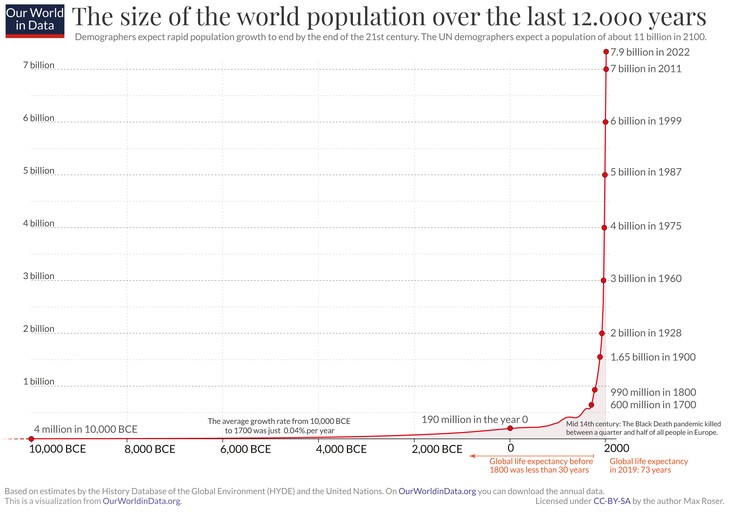
A cold Earth is a nearly dead Earth. A warm Earth is filled with life. Go to the tropics, then visit northern Canada. The difference is stark.
If you look at the world population chart you will notice that industrialization and population are correlated. As energy use per capita grew, the number of people exploded. Much of that is due to improved medical technology, but even more of it is due to the increase in our ability to feed ourselves through industrialization.
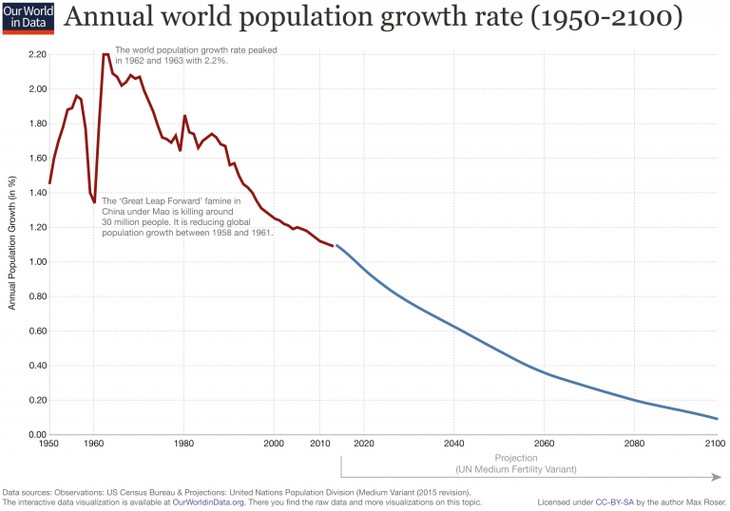
If you are excessively worried that the human population is outgrowing its ability to feed itself, fear not. As our population has skyrocketed over the past few decades the growth rate has slowed drastically, and will continue to do so. If I were you I would worry more about the rapid aging of our population than being overwhelmed in a Soylent Green population bomb. This is one reason why pro-natalists are worried so much–as the population ages out our social welfare states will be put under greater and greater strain.
Perhaps, though, that too will be overcome by technology. Japan is struggling with these issues and is trying to adapt to changing demographics. Immigration is not on the table there, unlike in many Western countries for good or ill.
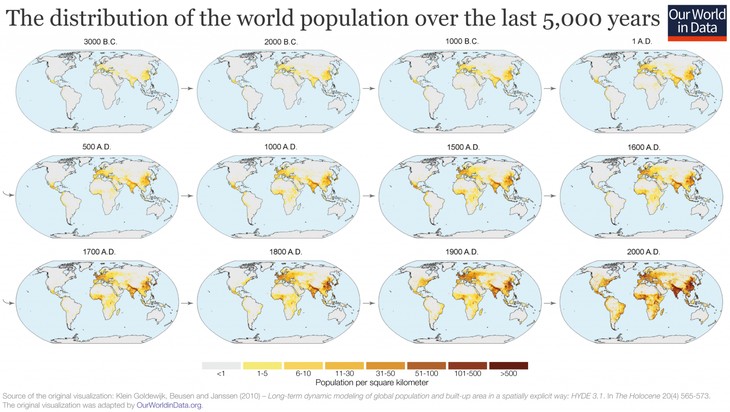
A quick view of the geographic distribution of population over time also reaffirms my assertion that we need not fear a warming of the Earth’s effects on human well-being. As you can see, human population has traditionally been concentrated around the equator, and to a great extent still is. Our ability to live in colder climates is an adaptation, not a normal optimal condition for human flourishing. Nobody’s vision of the Garden of Eden includes snow, because cold sucks.
The only arguments for worrying about global warming that have any traction with me have to do with changes to the ocean flows and chemistry. The ocean has far more impact on climate and weather conditions than the chemistry of the atmosphere. It is an enormous heat sink, distributes energy around the globe (which is why much of Europe is quite temperate despite being at high latitudes), and of course we know little about the ocean’s ecosystems.
Were I a climate scientist I would focus my efforts on two things in particular: the effects on ocean life of changing ph values, and the effects of melting Greenland glaciers on the heat flow in the Atlantic. We know far less about these things than we should, and much of the research is filled with more scaremongering projections than actual concrete knowledge.
We do know, though, that vast amounts of fresh water has been dumped into the oceans in recent times. The melting of the glaciers 10-15 millennia released unimaginable amounts of water into the oceans, and at least at that time the effects appear to have been for the better, not worse.
We often hear scare stories about 1 to 2 feet of sea level rise–for which there is sparse evidence–without any context. Since the last glacial maximum a few millennia ago sea levels have risen by hundreds of feet.
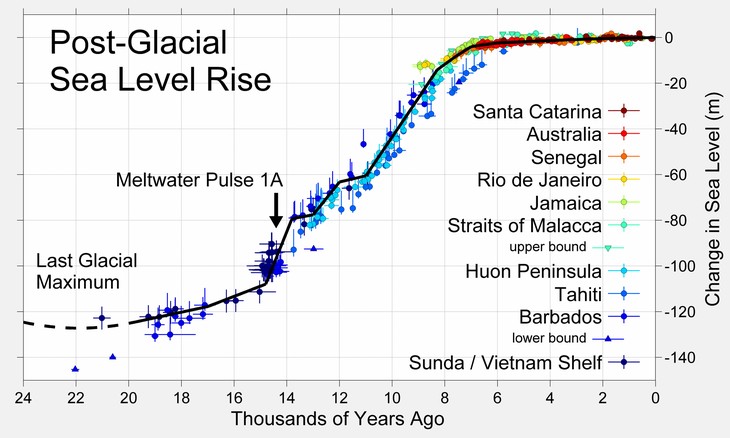
20,000 years ago the sea level was around 400 FEET lower than it is today. That is an astronomical amount of water that poured into oceans in a geological eyeblink–and as all that cold water flowed into the world’s oceans the human population exploded from less than a million to 8 billion. Any projected increase of sea levels from the melting of the world’s glaciers would literally be unnoticeable on this chart.
We also have direct, experiential evidence that the models which predict disaster are flawed. Islands that were projected to be under water have expanded in size. Snowfall was supposed to be a thing of the past in Great Britain, but has persisted nonetheless. Pretty much every prediction made from climate models has flunked the “compare to reality” test.
Climate science should be thriving and exciting because–like astronomy, biology, cutting edge physics–there is so damn much to learn. The systems are complex, we understand so little of it, and our ability to measure things and model them improves every day.
Instead, climate science is a political mess. The most basic mistakes are made (or falsehoods constructed), dissent is utterly annihilated, funding flows only to those who repeat a ridiculous narrative, and politicians have more influence than good scientists.
Government funding of scientific research can be a boon, but in many cases it has been precisely the opposite. The granting process rewards consensus and ideology too often trumps original thinking. The results are plain to see, with a public health bureaucracy parroting idiocies, scientific publications denying obvious realities, and the medical establishment prescribing mutilation of children as a treatment for mental illness.
I have compared this to Lysenkoism before, and I think the comparison is apt. Anti-science and anti-human ideology causing havoc and even death. Impoverishing people in the name of upholding a false consensus driven by political ideology.
Which gets us back to The Lancet study. Excessive heat is 1/9 as likely to kill a person as excessive cold, yet all we hear about is heat waves and heat misery.
The facts clearly don’t back up the Narrative™, but as usual the facts are utterly irrelevant.
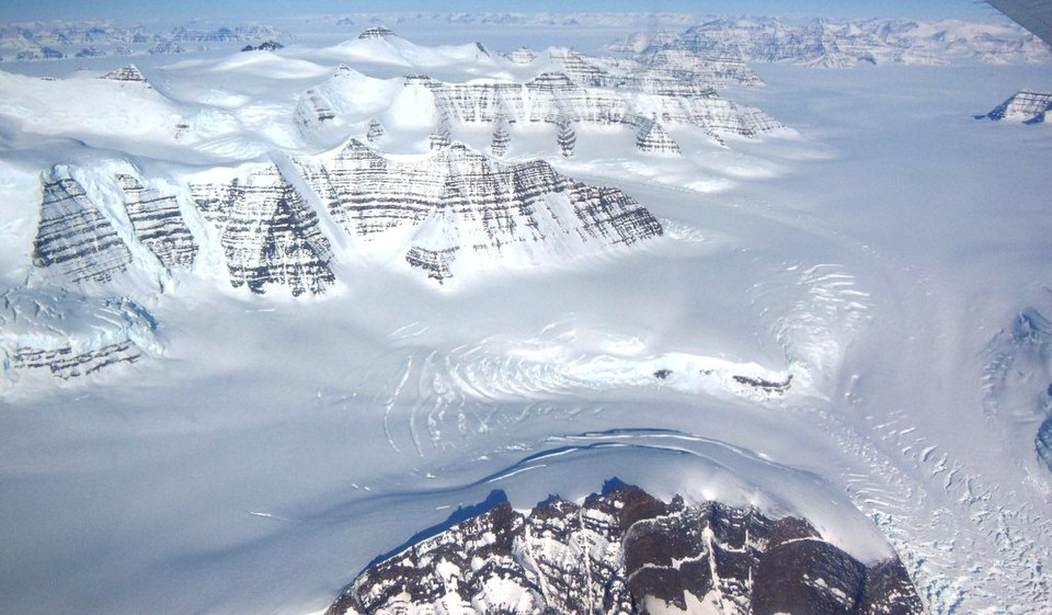







Join the conversation as a VIP Member